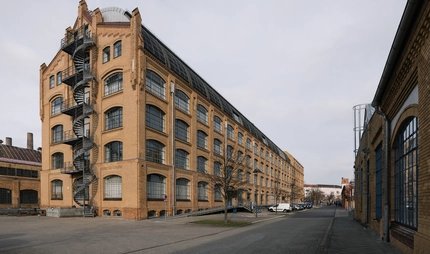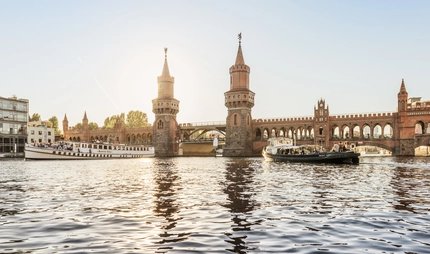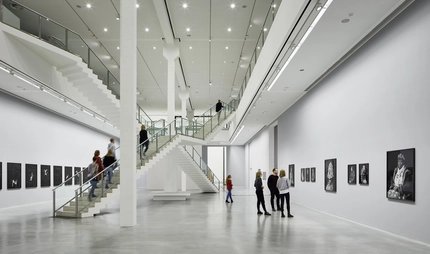
Ritterstraße-Nord residential complex
A retreat in the urban jungle
For the first time since the IBA in 1957, West Berlin once again hosted an international building exhibition that showed the new directions urban planning was taking.
Berlin in the eighties: The spirit of the times was changing. In the field of architecture, the focus was no longer on striving for modernity, characterised by the demolition of old buildings and the construction of new estates on the outskirts of the city. The focus of urban development – also due to protests from parts of the population – was on upgrading of the inner cities and a renaissance of the industrial revolution era houses. This was done by means of the renovation and gutting of old buildings on the one hand and by the construction of new residential complexes on the other.
Retreat in the city
Such a complex was built in 1981 in southern Friedrichstadt. Today centrally located in the city centre, when the city was divided the site was close to the Berlin Wall.
After renowned architects such as Hans Kollhoff had already completed housing projects there, the Luxembourg architect Rob Krier took on the task of planning the Ritterstraße-Nord residential complex between Lindenstraße and Alte Jakobstraße. Krier had already designed the Ritterstraße-Süd section at the end of the 1970s, but this second part to the north of the street was much larger with a total of 315 apartments in 35 buildings. The complex was thus one of the largest projects of the IBA.
Krier's most striking design feature: the arrangement of perimeter block buildings around residential courtyards, which can only be reached via gatehouses. Feilnerstraße forms a central axis, around which four apartment blocks are grouped. With this closed building design, the architect wanted to keep the living space “completely shielded from its shattered environment”. In spite of the inner city location, there were to be opportunities for retreat and relaxation.
Seamless transition
A total of seven architecture companies were involved in the individual designs of the buildings, among the architects was Axel Schultes, who later designed the Federal Chancellery [internal link]. Together, the offices developed the concept for the complex and created individual yet harmoniously coordinated buildings.
The style is postmodern, which also means that a widely varied mix of materials and shapes can be found here. On Ritterstraße and in the interior, the façades are brightly plastered, a contrast to the reddish-brown brick façades facing Lindenstraße, Oranienstraße and Alte Jakobstraße.
One of these brick buildings is also the former National Debt Administration at the corner of Oranienstraße and Alte Jakobstraße, which today houses the Health, Care and Equality department of the state of Berlin. The expressionist building designed by architect German Bestelmeyer dates from the Weimar Republic. After its renovation, it blended seamlessly with the Ritterstraße-Nord residential complex, in line with the IBA's plans for the continued use of modernised old buildings.
Playful use of historical references is an important part of postmodern architecture. The best example is the Feilnerhaus at Feilnerstraße 4, designed by Rob Krier. This used to be the site of a classicist residential building designed by Karl Friedrich Schinkel, which burnt down during the Second World War. The proportions of the building and structural details such as cornices and window dimensions are reminiscent of the previous building. Krier also borrowed from history in the use of arcade arches, which divide the brick façades on Feilnerstraße.

Space for places
The central point of the residential complex is the Schinkelplatz, a 30-meter-wide square, framed by four gatehouses. From here all parts of the complex can be reached, passages in the corners of the square lead to the four large garden courtyards. Each of them follows an own design concept of the architects Jasper Halfmann and Klaus Zillich. To the northwest is the Pergola garden, with plant-covered porticoes and a children's playground. In the northeastern courtyard there are small tenant gardens for the residents of the ground floor apartments, here another pergola provides privacy. Such colonnades are also found in the other two yard gardens, the "Zellgarten" (cell garden) and the "Gehirngarten" (brain garden). For the latter, Halfmann and Zillich were inspired by a cross-section of the human brain.
The surroundings of the residential complex, about which Rob Krier spoke in the early eighties, have not been “shattered” for a long time now. But the residential courtyards continue to create a perfect retreat for all those who need a break from city life.

Grand Tour of Modernism
To mark the 100th anniversary of the Bauhaus in 2019, the Bauhaus Association developed a Grand Tour of Modernism that takes architecture fans all over Germany. This residential complex is part of this theme route.
Grand Tour of Berlin Modernism
Our tips for the area around the Ritterstraße-Nord complex
One of Berlin's most popular attractions is within walking distance: Checkpoint Charlie, the former crossing point between the eastern and western parts of the city, can be found at Friedrichstraße 43-45.
If you follow Lindenstraße on foot to the south, you will come to the Jewish Museum designed by architect Daniel Libeskind. The deconstructivist architecture of the museum, the largest of its kind in Europe, is impressive. The permanent exhibition is currently being modernised and will be accessible again from 2020.
The Berlinische Galerie is also located in Alte Jakobstraße with exhibitions of fine arts, photography, architecture and graphic art.
Please note: The Berlinische Galerie is closed until 25 May. The lighting system of the rooms is being modernised.
You can see an interesting example of brutalistic ("raw concrete") sacral architecture in Alexandrinenstraße. This is the church of St. Agnes from the 1960s.
Practical information from visitBerlin
You can reach the Ritterstraße-Nord residential complex by taking U-Bahn line 6 to Kochstraße station. To explore the city, we recommend the Berlin Welcome Card for public transport.



